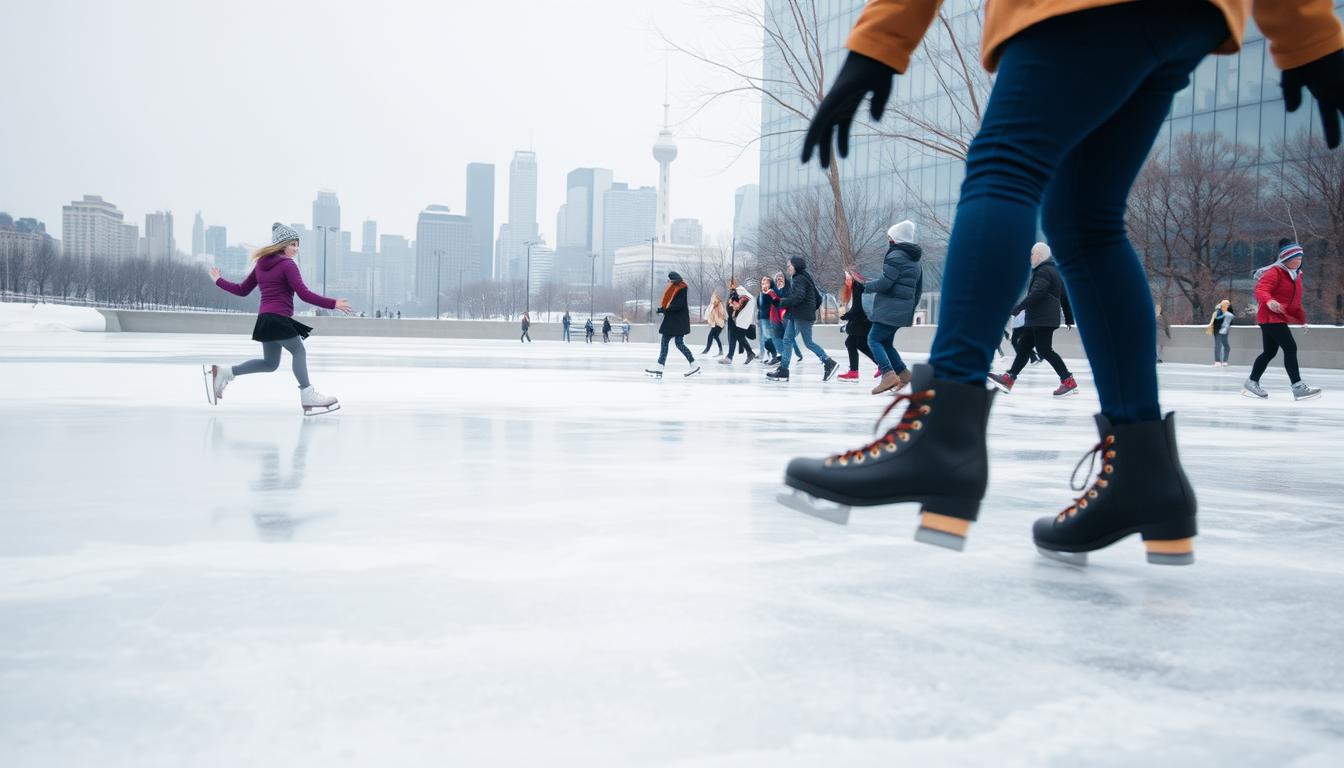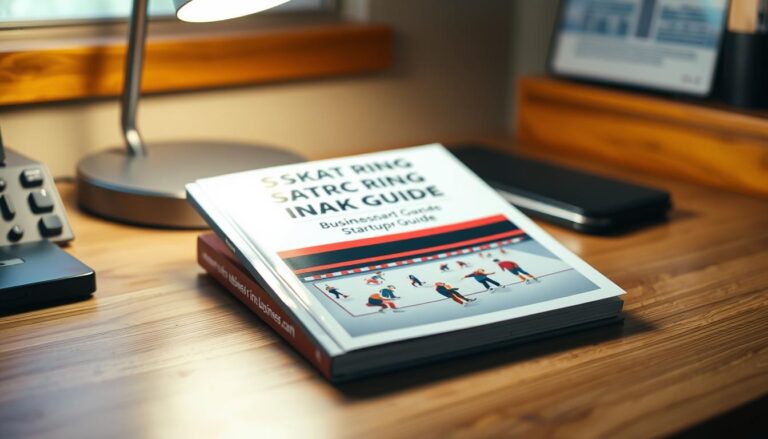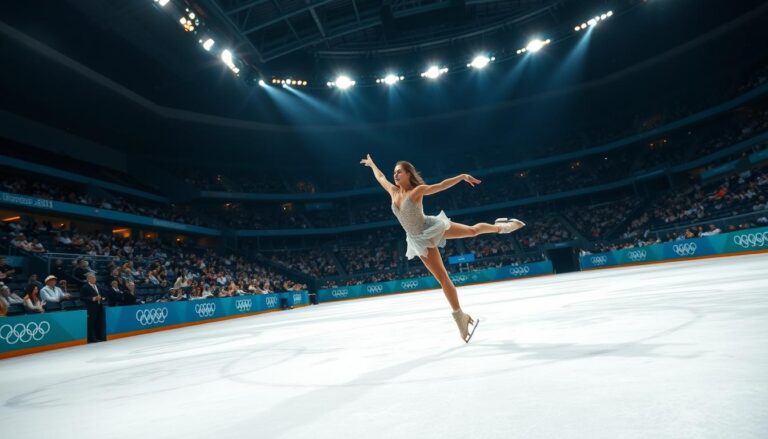Ice Skating is Often Harder to Learn at First Than Roller Skating
Imagine standing at the edge of a frozen rink, with your blades shining under the lights. You feel your muscles tighten. Many beginners find ice skating more challenging than roller skating at first.
The surface is key when comparing ice and roller skating. Ice is super smooth and slippery, requiring precision and balance. Roller skating, on the other hand, offers more grip and stability, making it easier for newbies to get started.
Ice skating needs a special set of skills. Your body must adjust to a surface that’s very slippery, affecting your balance with every move. Roller skaters often struggle because ice skating requires better control over your weight and edges.
Experts agree: ice skating is harder for beginners. It’s because ice skating involves managing your speed and balance on a surface that’s hard to control. This makes every step and stop more complex.
Starting out on ice is tougher. The thin blades mean you’re balancing on a tiny area, unlike roller skates. You need strong core muscles, better body awareness, and focus to stay in control.
Despite the hurdles, ice skating is thrilling and rewarding for those who keep trying. Knowing the differences between ice and roller skating helps beginners set realistic goals and learn effectively.
Understanding the Basic Differences Between Ice and Roller Skating
Skating has two main types: ice and roller skating. Both are fun but offer different challenges. Knowing these differences helps skaters pick what suits them best.
When deciding between ice and roller skating, several factors matter. The surface and equipment greatly affect the difficulty and feel of each style.
Surface and Friction Characteristics
The main difference is how each interacts with the surface:
- Ice skating is on a smooth, slippery surface with little friction
- Roller skating is on harder surfaces with more grip
- Ice gives a smooth glide, while roller skating is more controlled
Equipment Design and Structure
Equipment greatly influences the skating experience:
- Ice skates have a single, thin blade for precision
- Roller skates have multiple wheels for better contact
- Ice skates require more balance due to their design
Physical Environment Considerations
The environment also plays a big role in difficulty:
- Ice rinks have controlled, temperature-regulated conditions
- Roller skating can be indoors or outdoors
- Temperature and surface changes affect performance
Knowing these differences helps skaters enjoy their skating more. It guides them to the most fun experience.
Is Ice Skating Harder Than Roller Skating: A Detailed Analysis
Exploring ice skating versus roller skating shows a unique challenge for beginners. It’s not just a simple question of which is harder. Each sport has its own hurdles that test a person’s skills and willpower.

Looking at ice skating vs roller skating, several important points stand out:
- Surface Dynamics: Ice is very slippery, requiring exact balance
- Roller skating has more grip and stability for beginners
- Mastering blade control on ice needs a lot of technical skill
Experts suggest understanding the main differences between these sports. The learning pace changes a lot based on your athletic level and past experience.
| Skating Type | Balance Difficulty | Initial Learning Curve | Skill Progression |
|---|---|---|---|
| Ice Skating | High | Steeper | More Technical |
| Roller Skating | Moderate | Gentler | More Intuitive |
Your athletic background is key in figuring out which sport is harder for you. Some find that having strong core muscles and balance skills helps a lot at first.
The main point is, neither sport is inherently easier. They just need different skills and ways to move on wheels or blades.
The Science Behind Ice Skating Movement and Balance
Understanding the physics of ice skating is key when comparing it to roller skating. Ice skating is a unique challenge. It tests your body’s balance, momentum, and control in ways other sports can’t.
Ice skating requires a deep understanding of biomechanics. This is different from roller skating. The low friction environment demands exceptional skill and body awareness.
Edge Control and Weight Distribution
Mastering edge control is essential for ice skating. Skaters need to develop precise skills. They must manage their weight on two critical edges:
- Inside edge control
- Outside edge control
- Balanced weight transfer techniques
Center of Gravity Management
When comparing ice skating and roller skating, managing center of gravity is key. Ice skaters must adjust their body to stay stable on the smooth surface.
| Skill Component | Ice Skating Difficulty | Roller Skating Difficulty |
|---|---|---|
| Balance Complexity | High | Moderate |
| Surface Adaptability | Very Low | Moderate |
| Core Strength Requirement | Extremely High | Moderate |
Momentum and Glide Dynamics
The science of momentum on ice is fascinating. Minimal friction allows for extended glides. But, it requires precise technique to keep speed. Professional ice skaters turn physics into beautiful movements.
Every movement is a dance of force, balance, and technique. This makes ice skating a remarkable test of human physical ability.
Initial Learning Curve for Ice Skating Beginners
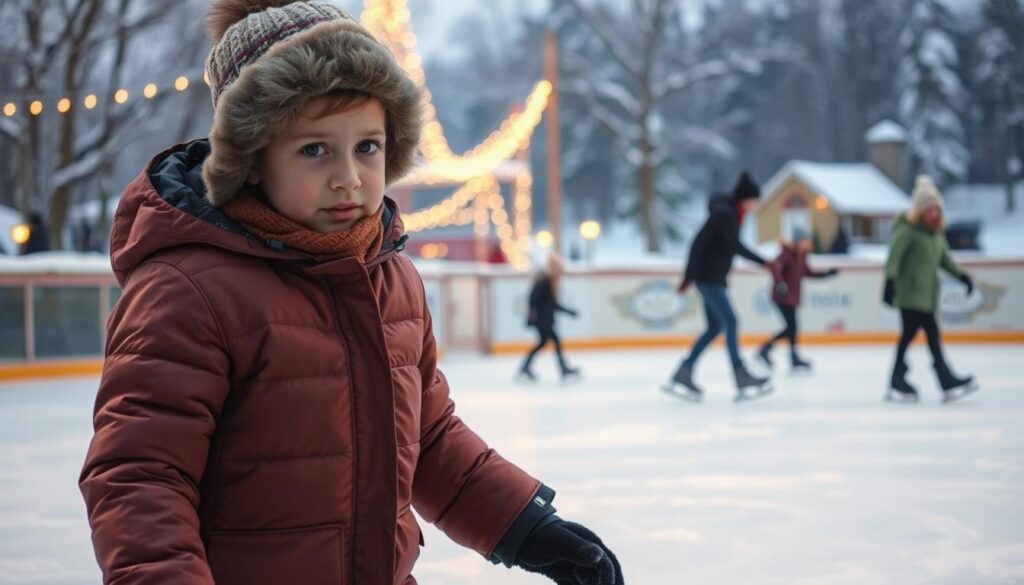
Stepping onto the ice for the first time is like entering a new world. Ice skating and roller skating have different challenges for beginners. Your first moments on the ice will test your balance, coordination, and courage.
New skaters soon find that ice skating skill level differences are clear from the start. Unlike roller skating, ice skating requires a more precise balance and movement. The slippery surface makes it hard for beginners to get the hang of it.
- Expect to spend your first sessions focusing on basic stability
- Learn fundamental techniques for maintaining balance
- Practice falling safely to build confidence
- Develop core strength and muscle memory
The initial learning curve follows a predictable pattern:
- First Session: Extreme wobbling and frequent falls
- Second to Third Session: Gradual improvement in balance
- Fourth to Fifth Session: Basic forward movement and stopping techniques
Professional instructors suggest starting with these key strategies:
- Bend your knees slightly for better stability
- Keep your weight centered over your skating blades
- Look forward, not down at your feet
- Wear protective gear to build confidence
Your progress will depend on your athletic ability, previous skating experience, and consistent practice. Most beginners start feeling more comfortable within 3-5 skating sessions. They go from being nervous novices to confident gliders.
Roller Skating Fundamentals and Learning Progression
Roller skating is often easier for beginners than ice skating. It offers a mix of challenge and ease that’s fun for newbies.
Getting Started with Your Basic Stance
Learning roller skating begins with the right stance. Unlike ice skating, roller skates give more support, making balance easier. Here’s how to stand right:
- Keep your knees slightly bent
- Keep your center of gravity low
- Spread your weight evenly on both skates
Essential Movement Techniques
Roller skating requires specific skills, unlike ice skating. Most beginners find it more natural. Focus on:
- Move by pushing off with side-to-side steps
- Keep your movements smooth and gliding
- Control your speed and direction
Safety Skills and Stopping Methods
Stopping is key when comparing ice and roller skating. Roller skating has several safe stopping methods:
- Toe Stop: Great for beginners
- T-Stop: Stops by sliding one foot
- Plow Stop: Stopping by widening your feet
Navigating Common Beginner Challenges
Every beginner faces challenges. Roller skating has its own, helping you grow and feel confident. You’ll learn to manage speed, turn, and adapt to different places.
Practice regularly to get better. Wear protective gear, stay patient, and keep a positive mindset. This will help you advance in roller skating.
Safety Considerations and Fall Prevention in Both Sports
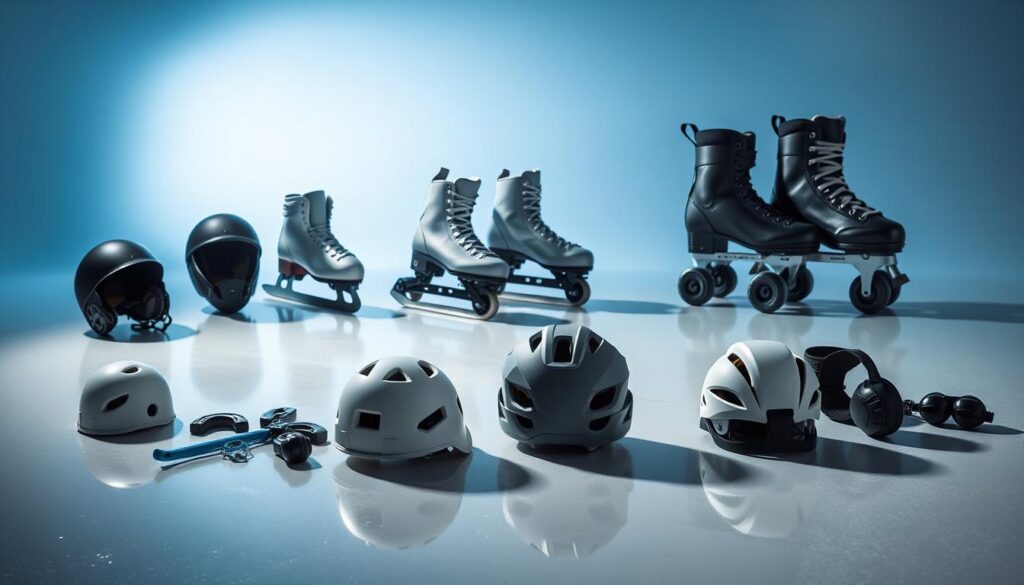
When we look at ice skating and roller skating, safety is key. Both sports have their own risks that need careful attention and protection.
Figuring out which is harder – ice skating or roller skating – starts with the safety risks. Ice skating is slippery and hard, while roller skating has its own dangers.
- Ice Skating Safety Considerations:
- Hard surface increases fall impact risk
- Blade management critical for prevention
- Specialized helmets recommended
- Roller Skating Safety Precautions:
- Uneven terrain can be a challenge
- Multiple protective gear is needed
- Being aware of the surface is important
Experts say beginners should wear full protective gear. Important safety items include:
| Equipment | Ice Skating | Roller Skating |
|---|---|---|
| Helmet | Essential | Essential |
| Knee Pads | Recommended | Critical |
| Wrist Guards | Optional | Highly Recommended |
Learning how to prevent falls in each sport can lower injury risks. Ice skaters should work on controlling their edges and staying low. Roller skaters need to practice balancing and stopping quickly.
Starting your safety journey means understanding each skating style’s unique aspects. With the right training, gear, and practice, you can enjoy skating safely and confidently.
Muscle Groups and Physical Demands in Ice Skating
Ice skating is a unique workout that challenges your body in special ways. It’s different from roller skating because it requires intense precision in engaging multiple muscle groups.
Your body turns into a dynamic machine while ice skating. Different muscles work together in amazing harmony. The difference in muscle needs between ice and roller skating is clear when you look closely.
Core Strength Requirements
Core muscles are key to balance and power in ice skating. They work hard to:
- Keep your body stable on the ice
- Control rotations in complex moves
- Support smooth weight shifts and transitions
Lower Body Engagement Patterns
Lower body muscles face the biggest challenges in ice skating. Skaters build incredible strength in certain muscles.
| Muscle Group | Primary Function | Engagement Level |
|---|---|---|
| Quadriceps | Propulsion and balance | High |
| Hamstrings | Edge control and stopping | Moderate to High |
| Calves | Ankle stability and precise movements | Extremely High |
| Glutes | Power generation and lateral movement | High |
Professional ice skaters have extraordinary muscular endurance. Their training goes beyond what most athletes do. The need to adjust constantly while gliding on ice makes it a full-body workout for even the best athletes.
Time Investment Required for Basic Proficiency
Learning ice skating and roller skating has its own challenges for beginners. Knowing how much time you’ll need is key when choosing which one to start with.
How fast you learn skating depends on several things. Everyone learns at their own pace. But, there are some general guidelines to help you know what to expect.
| Skating Type | Basic Skills Timeframe | Advanced Skills Timeframe |
|---|---|---|
| Ice Skating | 6-8 hours | 20-30 hours |
| Roller Skating | 4-6 hours | 15-25 hours |
So, is ice skating or roller skating harder? It really depends on your athletic level and how often you practice. Here are some things to think about:
- How often you practice affects how fast you learn
- Your balance and coordination are very important
- Training off the ice can help you get better faster
Experts say to practice regularly. Try to practice at least once a week to get better and feel more confident. How fast you improve depends on how dedicated you are, your fitness level, and how well you handle falls.
Keep in mind, every skater’s journey is different. Some might pick up skills quickly, while others need more time and patience. The most important thing is to enjoy the process and stay motivated.
Common Mistakes and How to Avoid Them in Both Disciplines
Learning ice skating and roller skating needs you to know and beat common problems. The ice skating vs roller skating difficulty comparison shows unique hurdles in both areas.
Starting to understand the differences in skill levels between ice and roller skating is key. It begins with spotting and fixing basic mistakes. Let’s look at the most common errors that beginners face.
Balance-Related Errors to Watch Out For
- Incorrect Body Positioning: Leaning too far back reduces control and increases fall risks
- Looking down at your feet disrupts your center of gravity
- Stiff, locked legs prevent smooth weight transfer
Technical Form Challenges
- Ice Skating Specific Issues:
- Not bending knees enough
- Poor edge control
- Inconsistent weight distribution
- Roller Skating Technique Problems:
- Feet positioned too close together
- Rigid arm positioning
- Incorrect ankle alignment
Staying ahead of these mistakes needs regular practice and being aware. Experts suggest using video analysis and specific drills to boost your skills on both ice and roller skates.
Remember, every skater faces challenges. Knowing how to spot and fix these issues will greatly enhance your performance and confidence on skates.
Transitioning Between Ice and Roller Skating Skills
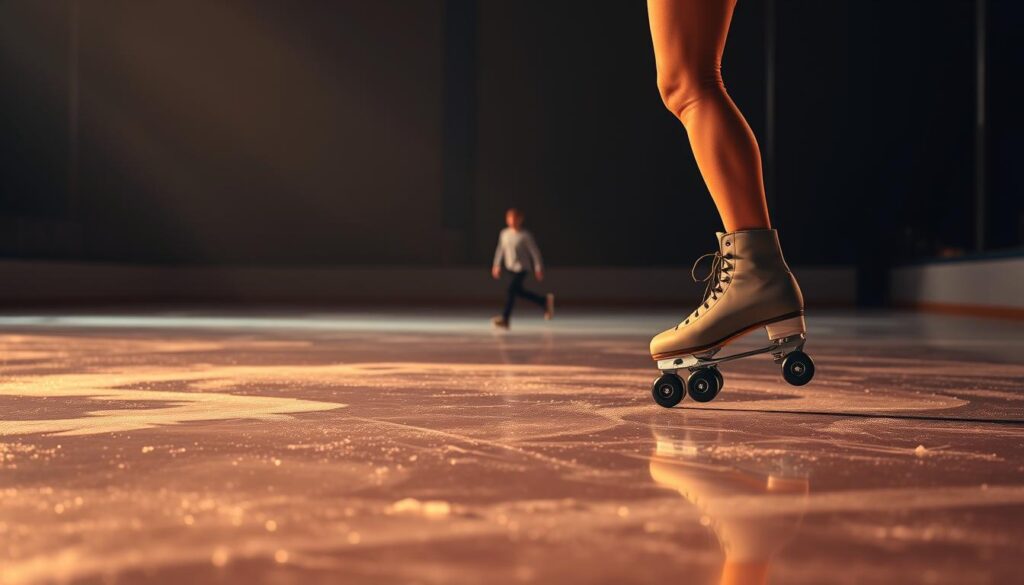
Learning to skate on ice and wheels is a thrilling adventure. Both share basic movement skills, but there are key differences. Knowing these differences is important when you compare ice and roller skating.
When you move from ice to wheels, or vice versa, you’ll find new skills. The question is, is ice skating harder than roller skating? It really depends on your current skills and how well you adapt.
- Core balance techniques remain similar across both skating types
- Weight distribution requires different approaches on ice versus wheels
- Edge control varies significantly between surface types
Here are some tips for making the switch:
- Develop ankle strength through cross-training
- Practice stance modifications
- Understand friction differences
- Master alternative stopping techniques
Many pros use roller skating to improve their ice skills. They find that skills from one type help in the other. This makes learning easier and more natural.
Remember, patience is key when exploring ice and wheel skating. Each surface has its own challenges. But with hard work, you’ll skate smoothly on both ice and wheels.
Equipment Costs and Accessibility Comparison
When you’re deciding between ice skating and roller skating, knowing the costs is key. The money you spend and how easy it is to get started can really shape your skating adventure.
Ice skating often means a bigger upfront cost. Newbies might spend $100 to $500 on good ice skates. But, ice skating also means extra costs for maintenance and finding a place to skate.
- Ice Skate Costs:
- Beginner skates: $100-$500
- Blade sharpening: $10-$20 per session
- Rink admission: $10-$25 per visit
- Roller Skate Costs:
- Beginner skates: $50-$200
- Wheel replacement: $30-$60 annually
- Outdoor skating: Free
Roller skating is a more affordable choice for beginners. It’s cheaper to start and you can skate almost anywhere, making it a great option for those new to skating.
Pro Tip: Think about where you live and how much you can spend when picking between ice and roller skating. The place you skate and your personal likes can really affect your experience.
Roller skating lets you skate on streets, parks, and bike paths. Ice skating, on the other hand, usually means skating at a rink with special conditions.
| Skating Type | Initial Cost | Maintenance | Accessibility |
|---|---|---|---|
| Ice Skating | $100-$500 | Blade sharpening | Rink-dependent |
| Roller Skating | $50-$200 | Wheel replacement | Multiple environments |
Your choice should match your interests, budget, and what’s available locally. Both ice and roller skating offer fun and fitness, each in their own way.
Benefits of Starting with Roller Skating Before Ice Skating
Starting your skating journey can seem scary. But, roller skating first has big benefits. It helps you learn ice skating skills better and feel more confident.
Transferable Skills Development
Roller skating is a great way to learn ice skating. It makes learning ice skating easier. You get to practice important skills first.
- Balance and weight distribution skills
- Core muscle engagement
- Coordination and body awareness
- Basic momentum generation techniques
Confidence Building Pathways
Roller skating is a softer way to start skating. It’s easier to learn because it’s not as slippery as ice. This helps you get used to moving without feeling too scared.
- Practice in familiar environments
- Lower initial learning curve
- Faster skill progression
- Reduced intimidation factor
Even pro athletes use roller skating to get better at ice skating. Your roller skating experience becomes a strategic advantage in your skating evolution.
Conclusion
Ice skating and roller skating are both worlds of balance and skill. Ice skating might be harder to learn at first. But both need dedication and a love for learning.
Which is tougher, ice skating or roller skating? It really depends on you. Skaters face different challenges with each sport. Some find ice scary, while others love the roller skating tricks.
Skating is more than just skills. It helps you get stronger and balance better. It’s a fun way to stay active. Enjoy the ride, whether on ice or wheels.
Ready to start skating? Get your skates and find a place to skate. Your journey is just beginning. Enjoy every step of the way.
